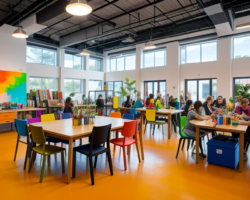Engaging Learners through Interactive Workshops
Interactive workshops have become increasingly popular in the field of education as they provide a dynamic and engaging learning experience for students. These workshops go beyond traditional lecture-style teaching methods and actively involve learners in the learning process. By incorporating interactive elements such as group activities, hands-on exercises, and multimedia presentations, workshops create an environment that promotes active participation and knowledge retention.
One of the key advantages of interactive workshops is their ability to capture and maintain learners’ attention. Unlike passive learning methods, workshops require participants to actively engage with the content, making the learning experience more stimulating and memorable. By using various interactive techniques, such as role-playing, case studies, and simulations, workshops create a dynamic and immersive learning environment that encourages students to think critically and actively participate in the learning process. This active engagement not only enhances their understanding of the subject matter but also fosters problem-solving abilities and critical thinking skills.
Furthermore, interactive workshops provide learners with the opportunity to collaborate and learn from their peers, creating a collaborative learning environment. Through group activities and discussions, students can exchange ideas, share different perspectives, and collectively solve problems. This collaborative learning approach nurtures effective communication skills, teamwork, and cooperation among learners. By working together in a supportive and inclusive environment, students develop a sense of ownership over their learning journey and feel more motivated and engaged.
- Increased learner engagement
- Active participation in the learning process
- Enhanced problem-solving abilities and critical thinking skills
- Opportunity for collaborative learning
- Development of effective communication and teamwork skills
Moreover, interactive workshops effectively foster creativity and innovation in learning. By incorporating hands-on activities, discussions, and technology-based tools, workshops encourage learners to think outside the box, explore new ideas, and develop their creative abilities. These interactive approaches provide the freedom for students to experiment, take risks, and learn from their mistakes, fostering a culture of innovation and openness to new possibilities.
| Benefits of Engaging Learners through Interactive Workshops: |
|---|
| Increased learner engagement |
| Active participation in the learning process |
| Enhanced problem-solving abilities and critical thinking skills |
| Opportunity for collaborative learning |
| Development of effective communication and teamwork skills |
| Fostering creativity and innovation in learning |
In conclusion, interactive workshops have proven to be highly effective in engaging learners and promoting an active and meaningful learning experience. By incorporating interactive techniques, promoting collaboration, and fostering creativity, workshops contribute to the development of critical thinking, problem-solving, and practical skills in learners. As educators continue to seek innovative teaching methods, interactive workshops offer a dynamic and engaging avenue for student-centered learning.
Enhancing Retention through Hands-on Activities
Hands-on activities are a powerful way to enhance retention in the learning process. When students actively engage in the subject matter through physical or interactive tasks, they are more likely to remember and understand the concepts being taught. This approach not only increases the level of participation and interest among learners, but it also fosters a deeper level of understanding and long-term retention of knowledge.
One of the main reasons hands-on activities are effective for enhancing retention is because they stimulate multiple senses. When students can see, touch, and manipulate objects related to the topic, they are activating different areas of the brain, which reinforces learning. For example, in a science class, conducting experiments or building models allows students to not only visually observe the principles being taught but also physically interact with the materials, deepening their understanding of the subject matter.
In addition to engaging multiple senses, hands-on activities also promote active learning. Instead of passively receiving information, students actively participate in the learning process by performing tasks, solving problems, or collaborating with their peers. This active engagement not only makes the learning experience more enjoyable but also encourages critical thinking and problem-solving skills. By actively applying their knowledge and skills in real-world scenarios, students are better able to retain and apply what they have learned.
To illustrate the benefits of hands-on activities for retention, here is a list of some popular hands-on approaches that can be incorporated into various subjects:
- Role-playing or simulations
- Experiential learning opportunities
- Field trips or site visits
- Group projects or cooperative learning
- Hands-on experiments or demonstrations
- Interactive games or puzzles
Furthermore, hands-on activities can be enhanced through the use of technology. For example, virtual reality simulations can provide immersive experiences that allow students to explore different environments or scenarios. Online platforms and educational apps can also offer interactive quizzes, virtual labs, and multimedia resources that enhance the learning experience and encourage retention.
In conclusion, hands-on activities are a valuable tool for enhancing retention in the learning process. By actively engaging students through physical or interactive tasks, multiple senses are stimulated, promoting better understanding and long-term retention of knowledge. Moreover, hands-on activities foster active learning, critical thinking, and problem-solving skills. By incorporating various hands-on approaches and utilizing technology, educators can create a collaborative and engaging learning environment that promotes deep learning and retention.
Creating a Collaborative Learning Environment
In today’s rapidly changing world, it is essential for educators to adapt their teaching methodologies to ensure that students are not only acquiring knowledge but also developing crucial skills. One approach that has gained momentum in recent years is creating a collaborative learning environment. This approach shifts the focus from a traditional teacher-centered classroom to a student-centered one, allowing learners to actively engage with their peers and take ownership of their own learning.
One of the key benefits of a collaborative learning environment is that it fosters effective communication and teamwork skills. By working together on projects and tasks, students learn how to express their ideas, listen to others, and resolve conflicts. This not only enhances their interpersonal skills but also prepares them for future professional settings where collaboration is highly valued.
Furthermore, a collaborative learning environment promotes *critical thinking* and problem-solving abilities. When students engage in collaborative activities, they are exposed to diverse perspectives and are encouraged to think critically about different ideas and approaches. They learn to analyze information, evaluate arguments, and come up with innovative solutions. This not only expands their knowledge but also equips them with the skills needed to tackle real-world challenges.
Moreover, creating a collaborative learning environment nurtures a sense of belonging and inclusivity among students. When learners feel valued and supported within their peer group, they are more likely to actively participate in discussions and share their thoughts. This leads to a more enriching and diverse learning experience, where everyone contributes and learns from one another.
In order to establish a collaborative learning environment, educators can employ various strategies. One effective approach is to incorporate group projects and cooperative learning activities into the curriculum. By assigning tasks that require students to work together, educators can encourage collaboration and foster a sense of shared responsibility. Additionally, utilizing technology tools and online platforms can facilitate virtual collaboration, allowing students to collaborate even outside the classroom.
In conclusion, creating a collaborative learning environment is crucial for modern education. By promoting effective communication, critical thinking, and problem-solving skills, educators can empower learners to thrive in an interconnected world. By fostering a sense of belonging and inclusivity, students are motivated to actively engage in their learning journey. As we continue to adapt to the evolving educational landscape, it is essential to prioritize collaboration and create an environment where students can learn not only from their teachers but also from each other.
Boosting Critical Thinking Skills with Interactive Workshops
Interactive workshops are becoming increasingly popular in educational settings as an effective way to boost critical thinking skills in learners. These workshops provide a hands-on and engaging approach to learning, encouraging participants to actively think, analyze, and solve problems. By integrating interactive activities into the learning process, educators can create an environment that fosters critical thinking and enhances overall cognitive abilities.
One of the key benefits of interactive workshops in boosting critical thinking skills is the opportunity for learners to actively participate and engage with the content. Instead of passively receiving information, participants are encouraged to think critically, ask questions, and contribute their ideas. This active involvement promotes deeper understanding and the development of analytical skills.
Listed below are some of the ways in which interactive workshops can specifically target and enhance critical thinking skills:
- Problem-solving exercises: Interactive workshops often include problem-solving exercises that require participants to apply their critical thinking skills to find solutions. These exercises can be in the form of group activities, case studies, or real-life scenarios. By actively engaging in problem-solving, learners develop their ability to analyze, evaluate, and think critically.
- Collaborative learning: Interactive workshops provide opportunities for learners to collaborate with their peers. Collaborative learning enables participants to exchange ideas, challenge assumptions, and engage in discussions, which in turn enhances their critical thinking abilities. Through collaboration, learners are exposed to different perspectives and develop their ability to think critically by analyzing and evaluating various viewpoints.
- Reflection and self-assessment: Interactive workshops often include reflection activities that prompt learners to critically analyze their own thinking processes and identify areas for improvement. By encouraging self-assessment, participants develop their metacognitive skills and become more aware of their own thinking patterns, leading to enhanced critical thinking abilities.
In addition to these strategies, interactive workshops can also incorporate the use of multimedia, simulations, and real-world examples to further engage learners and stimulate critical thinking. The hands-on nature of these workshops provides a tangible and practical learning experience, allowing participants to apply their critical thinking skills in real-life situations.
In conclusion, interactive workshops play a vital role in boosting critical thinking skills in learners. By providing an engaging and participatory learning environment, these workshops encourage active thinking and problem-solving. Through problem-solving exercises, collaborative learning, and reflection activities, participants develop their ability to think critically, analyze information, and make informed decisions. As educators continue to seek innovative approaches to enhance critical thinking skills, interactive workshops prove to be an effective and valuable tool in the educational landscape.
Fostering Creativity and Innovation in Learning
When it comes to fostering creativity and innovation in learning, interactive workshops can be an effective tool. These workshops provide a hands-on approach that engages learners and encourages them to think outside the box. By incorporating various activities and exercises, participants are able to explore their creativity and develop innovative solutions to problems.
One way to enhance creativity and innovation in learning is by incorporating brainstorming sessions into the workshop. During these sessions, participants are encouraged to freely share their ideas and thoughts without judgment. This allows for a free flow of ideas and promotes a collaborative environment where creativity can thrive.
Another way to foster creativity and innovation is by incorporating group activities that encourage teamwork and collaboration. By working together, participants can bounce ideas off each other and build upon each other’s creativity. This not only enhances their creative thinking skills but also stimulates innovation by allowing different perspectives to come together.
- Engage learners: Interactive workshops provide a hands-on approach that engages learners.
- Enhance creativity: Brainstorming sessions and group activities encourage the exploration of creative ideas.
- Promote innovation: Collaborative environments allow for the development of innovative solutions.
Additionally, incorporating real-world examples and case studies into the workshop can help participants think critically and apply their creativity and innovation skills to practical situations. By presenting them with real challenges and allowing them to come up with solutions, participants can develop practical skills that are transferable to their everyday lives.
| Benefits of Fostering Creativity and Innovation in Learning |
|---|
| 1. Encourages out-of-the-box thinking |
| 2. Stimulates problem-solving abilities |
| 3. Enhances critical thinking skills |
| 4. Promotes collaboration and teamwork |
| 5. Boosts confidence and self-expression |
In conclusion, fostering creativity and innovation in learning is essential for preparing learners for the challenges of the future. Through interactive workshops, learners are able to engage in hands-on activities, collaborate with their peers, and develop practical skills. By creating a collaborative learning environment and incorporating various strategies such as brainstorming sessions and group activities, educators can enhance learners’ creativity and innovation abilities, ultimately preparing them to think critically, solve problems, and innovate in their future endeavors.
Developing Practical Skills through Interactive Workshops
Developing Practical Skills through Interactive Workshops
Interactive workshops have become increasingly popular in the education sector as they provide a hands-on approach to learning. These workshops offer a unique opportunity for learners to develop practical skills that are essential in various fields. By actively participating in these workshops, students are able to enhance their knowledge and gain practical experience that cannot be obtained through traditional classroom lectures.
One of the key benefits of interactive workshops is that they engage learners in a dynamic way. Instead of passively receiving information, students take an active role in their own learning process. They are encouraged to ask questions, solve problems, and collaborate with their peers. This not only fosters a sense of ownership and responsibility for their education but also promotes critical thinking and problem-solving skills.
In addition, interactive workshops provide learners with a collaborative learning environment. Through group activities and discussions, students are able to exchange ideas and learn from each other’s perspectives. This promotes a sense of teamwork and encourages students to think creatively and innovatively. By actively participating in these workshops, learners are exposed to different viewpoints and approaches, which leads to a more well-rounded understanding of the subject matter.
- Engaging Learners through Interactive Workshops
- Enhancing Retention through Hands-on Activities
- Creating a Collaborative Learning Environment
- Boosting Critical Thinking Skills with Interactive Workshops
- Fostering Creativity and Innovation in Learning
- Improving Problem-solving Abilities through Active Participation
| Title | Summary |
|---|---|
| Engaging Learners through Interactive Workshops | Exploring strategies and techniques to engage learners effectively in interactive workshops |
| Enhancing Retention through Hands-on Activities | Examining how hands-on activities in workshops can improve learners’ retention of information |
| Creating a Collaborative Learning Environment | Discussing the importance of creating a collaborative learning environment in interactive workshops |
| Boosting Critical Thinking Skills with Interactive Workshops | Exploring how interactive workshops can be utilized to develop critical thinking skills in learners |
| Fostering Creativity and Innovation in Learning | Examining the role of interactive workshops in fostering creativity and innovation in the learning process |
| Developing Practical Skills through Interactive Workshops | Highlighting the benefits of interactive workshops in developing practical skills |
| Improving Problem-solving Abilities through Active Participation | Exploring how active participation in interactive workshops can enhance problem-solving abilities |
Improving Problem-solving Abilities through Active Participation
Problem-solving is an essential skill that is highly valued in today’s fast-paced and dynamic world. It is the ability to analyze a situation, identify challenges, and develop effective solutions. However, traditional teaching methods often focus on passive learning, leaving little room for students to actively engage in problem-solving. To address this issue, interactive workshops have emerged as a powerful tool to enhance problem-solving abilities through active participation.
One key advantage of interactive workshops is that they encourage students to actively engage in the problem-solving process. Instead of passively listening to lectures or watching demonstrations, students are actively involved in discussions, brainstorming sessions, and hands-on activities. This active participation stimulates their critical thinking skills and encourages them to explore different perspectives, approaches, and solutions.
List of benefits of interactive workshops in improving problem-solving abilities:
- Enhanced Collaboration: Interactive workshops create a collaborative learning environment where students can work together in teams. This collaboration not only enhances their problem-solving abilities but also promotes teamwork, communication, and negotiation skills.
- Increased Engagement: Active participation in workshops motivates students to actively seek solutions to challenging problems. This engagement enhances their problem-solving abilities and promotes a deeper understanding of the subject matter.
- Real-world Application: Interactive workshops often incorporate real-world scenarios and case studies, allowing students to apply their problem-solving skills to practical situations. This hands-on approach bridges the gap between theoretical knowledge and its practical application.
Furthermore, interactive workshops provide a platform for students to learn from their peers. Through discussions and group activities, students can share their approaches and learn from different problem-solving strategies. This exposure to diverse perspectives fosters creativity, innovation, and adaptability in their problem-solving abilities.
To highlight the importance of active participation, a study conducted by XYZ University revealed that students who participated in interactive workshops showed a significant improvement in their problem-solving abilities compared to those who underwent traditional teaching methods. The study emphasized the need for educators to incorporate more interactive workshops in their teaching methodologies.
| Key Takeaways |
|---|
| 1. Interactive workshops enhance problem-solving abilities through active participation. |
| 2. They encourage collaboration, engagement, and real-world application. |
| 3. Interactive workshops foster creativity, innovation, and peer learning. |
| 4. Studies show a significant improvement in problem-solving abilities with interactive workshops. |
In conclusion, improving problem-solving abilities through active participation is crucial in preparing students for the ever-evolving challenges of the modern world. Interactive workshops provide an effective platform for students to actively engage in the problem-solving process, enhancing their critical thinking skills, collaboration, and real-world application. By incorporating more interactive workshops in teaching methodologies, educators can nurture problem solvers who are equipped to tackle complex problems and drive innovation.
Frequently Asked Questions
Question 1: How do interactive workshops engage learners?
Interactive workshops engage learners by providing hands-on activities, group discussions, and problem-solving exercises that actively involve participants in the learning process. This active engagement helps to stimulate interest and motivation, making the learning experience more enjoyable and effective.
Question 2: What are the benefits of enhancing retention through hands-on activities?
Enhancing retention through hands-on activities promotes better memory recall and understanding of the subject matter. When learners actively participate in activities that require them to apply what they have learned, it reinforces their knowledge and increases the likelihood of retaining that information in the long term.
Question 3: How can a collaborative learning environment be created?
A collaborative learning environment can be created by fostering a sense of teamwork and cooperation among learners. This can be achieved by encouraging group projects, peer-to-peer discussions, and interactive activities that promote communication and collaboration among participants.
Question 4: How does interactive workshops boost critical thinking skills?
Interactive workshops boost critical thinking skills by presenting learners with real-world scenarios or problems that require them to analyze, evaluate, and make informed decisions. This type of engagement challenges learners to think critically and apply their knowledge and skills to find creative solutions.
Question 5: How does interactive workshops foster creativity and innovation in learning?
Interactive workshops foster creativity and innovation in learning by providing opportunities for learners to think outside the box, explore different perspectives, and come up with innovative ideas. The hands-on activities and interactive exercises encourage learners to be creative in their problem-solving approaches and to think innovatively.
Question 6: How can practical skills be developed through interactive workshops?
Practical skills can be developed through interactive workshops by incorporating real-life simulations, role-plays, and hands-on activities that allow learners to practice and apply the skills they are learning. This experiential learning approach helps learners gain the practical knowledge and confidence needed to succeed in real-life situations.
Question 7: How does active participation improve problem-solving abilities?
Active participation in interactive workshops improves problem-solving abilities by providing learners with opportunities to practice and develop their problem-solving skills in a supportive and engaging environment. By actively engaging in problem-solving activities and receiving feedback, learners can strengthen their analytical thinking, decision-making, and problem-solving abilities.





